 |

State of Alaska > DOLWD > Alaska
Economic Trends
2010 Alaska Economic Trends
Alaska Economic Trends are searchable from 1978 to the present using the Trends search page. The search can include any combination of the title or subtitle, date or date range, author, or full text.
|
| December 2010 |
Population Projections: 2010 to 2034 |
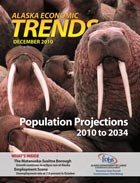 |
Population projections tell us more than how many people we should expect — they tell us what kinds of services we’ll need to support the future population. Alaskans use these projections to plan for social services like nursing homes, schools, and hospitals. This article is an overview of projected numbers for the state, regions, and borough/ census areas as well as the Alaska Native population. It also summarizes how the Department of Labor makes these projections and explains components of change (mortality, fertility, and migration).
December 2010 Trends |
| |
|
| November 2010 |
Employment in Alaska's Seafood Industry |
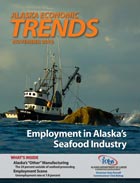 |
Alaska’s fishing industry is a major economic engine, leading the nation in fish harvesting value and poundage. Harvesting and processing also help drive our state economy. In 2009, the industry directly employed at least 53,500 workers at some point during the year.
This article is an overview of total workers and average monthly employment in the Alaska fishing industry. It also provides a focused look at species and regions, and reviews how we create annual size estimates using fish harvest records, wage records, and other data sources.
November 2010 Trends |
| |
|
| October 2010 |
Alaska's Mining Industry |
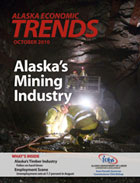 |
The discovery of gold in the late 1800s drew thousands of people to the far reaches of Alaska. In 1880, Joseph Juneau found large pieces of quartz mixed with gold in Southeast Alaska, and his find lured prospectors to the new town site of Juneau. A second boom hit two years later when gold deposits were found on Douglas Island, across the channel from Juneau, resulting in the creation of Treadwell Mine. Gold discoveries in 1896 launched the great Klondike gold rush. Thousands of prospectors passed through Alaska on their way to the Yukon, creating the town of Skagway. More finds of gold in 1898 drew boat loads of people to Nome’s sandy beaches on the Seward Peninsula.
October 2010 Trends |
| |
|
| September 2010 |
Industry and Occupational Forecasts - 2008 to 2018 |
 |
Between 2008 and 2018, Alaska is projected to recover from the aftermath of the recent recession and add 33,670 jobs, an increase of 10.5 percent. This compares to a 10.1 percent gain for the United States as a whole.
Alaska’s industry forecast is the result of varying rates of growth in different industries. Relatively slow growth is expected in most of the largest sectors including government, retail trade, finance, and education. Somewhat stronger growth is expected in small to medium size industries such as metal mining; utilities; and professional, scientific, and technical services. Exceptional growth is forecasted for health care related industries.
September 2010 Trends |
| |
|
| August 2010 |
The Cost of Living in Alaska |
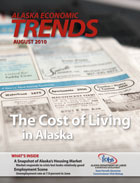 |
Alaska’s cost of living is frequently a topic of casual conversation and sometimes a cause for heated debates. For many years, a great deal of myth and lore has surrounded the idea of how much things cost in the Last Frontier. Cost of living information ranks among the most requested economic data. It’s also a story that is in constant flux, making up-to-date information vitally important. This article attempts to corral cost of living information from a variety of sources into one place.
August 2010 Trends
|
| |
|
| July 2010 |
The Trends 100 |
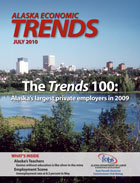 |
For the third year in a row, Providence Health & Services remained the only private-sector employer in the state with a work force of more than 4,000 employees. Continuing its recent growth, the company added 200 workers in 2009. (See Exhibit 1.) Wal-Mart/Sam’s Club remained the second largest and was the only other private employer with more than 3,000 employees. Carrs/Safeway was previously in that group but dipped slightly below 3,000 employees.
July 2010 Trends
|
| |
|
| June 2010 |
Tracking Alaska's Students |
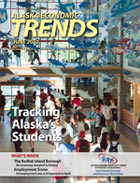 |
Not every young Alaskan takes the traditional path from secondary school to adult work life. The journey can
be a bumpy one, with detours and deadends. And just as initial success doesn’t necessarily lead to long-term success, failure in high school doesn’t necessarily mean long-term failure. But what path is most likely to lead to success for Alaska’s youth?
June 2010 Trends
|
| |
|
| May 2010 |
Older Workers in Alaska |
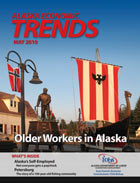 |
Alaska’s population has gotten older over the past 10 years. Alaska’s median age in 1998 was 27.5 compared to 33.5 in 2008. The percentage of older Alaskans has also increased over the past decade. In 1998, 5.4 percent of the state’s population was 65 and over, by 2008, the percentage rose to 7.3 percent.
May 2010 Trends |
| |
|
| April 2010 |
Alaska's 2009 Population |
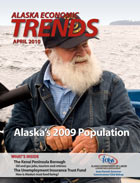 |
Alaska’s population increased 10.3 percent, or 64,781 people, from 2000 to 2009, bringing the state’s population to 692,314, based on estimates released in January by the Alaska Department of Labor and Workforce Development.
With only a year left in the decade, Alaska’s population has so far been growing at a slower average annual rate in the 2000s (1.1 percent) than in the 1990s (1.3 percent). Despite the trend of slow growth, Alaska’s population grew at an above-average rate from 2008 to 2009, increasing about 1.5 percent or 10,337 people.
April 2010 Trends |
| |
|
| March 2010 |
Alaska's Health Care Industry |
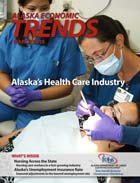 |
No Alaska industry has grown as much as health care, one of the state’s largest industries. It had at least 30,000 jobs in 2008 and its payroll was more than $1.4 billion. Health care employs more people in Alaska than the state government, oil industry or most other industries. And few industries are as geographically widespread and employ such a broad spectrum of occupations.
March 2010 Trends |
| |
|
| February 2010 |
Anchorage Migration |
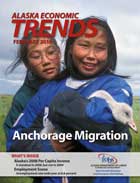 |
Are people leaving Alaska’s Native villages and other rural communities to move to Anchorage?
That question has recently been of substantial interest for educators, government and community leaders, and a wide range of service providers. Although attempts have been made to document the trends, questions persist. How many people are involved? What communities are losing people? What are the characteristics of the movers and are the movements permanent?
February 2010 Trends |
| |
|
| January 2010 |
Employment Forecast for 2010 |
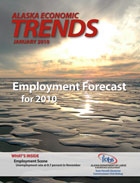 |
Alaska’s 21-year streak of job growth ended in 2009. It was a good run, especially for an economy that earned a boom-and-bust reputation during the eventful 1970s and 1980s.
Over the course of the 21-year span that began in 1988, the state chugged right through two national recessions – one in the early 1990s and another in 2001 – without suffering a serious setback in terms of job losses. Boom-and-bust Alaska had become old-reliable Alaska.
January 2010 Trends |
| |
|
Return to Top of Page
|















